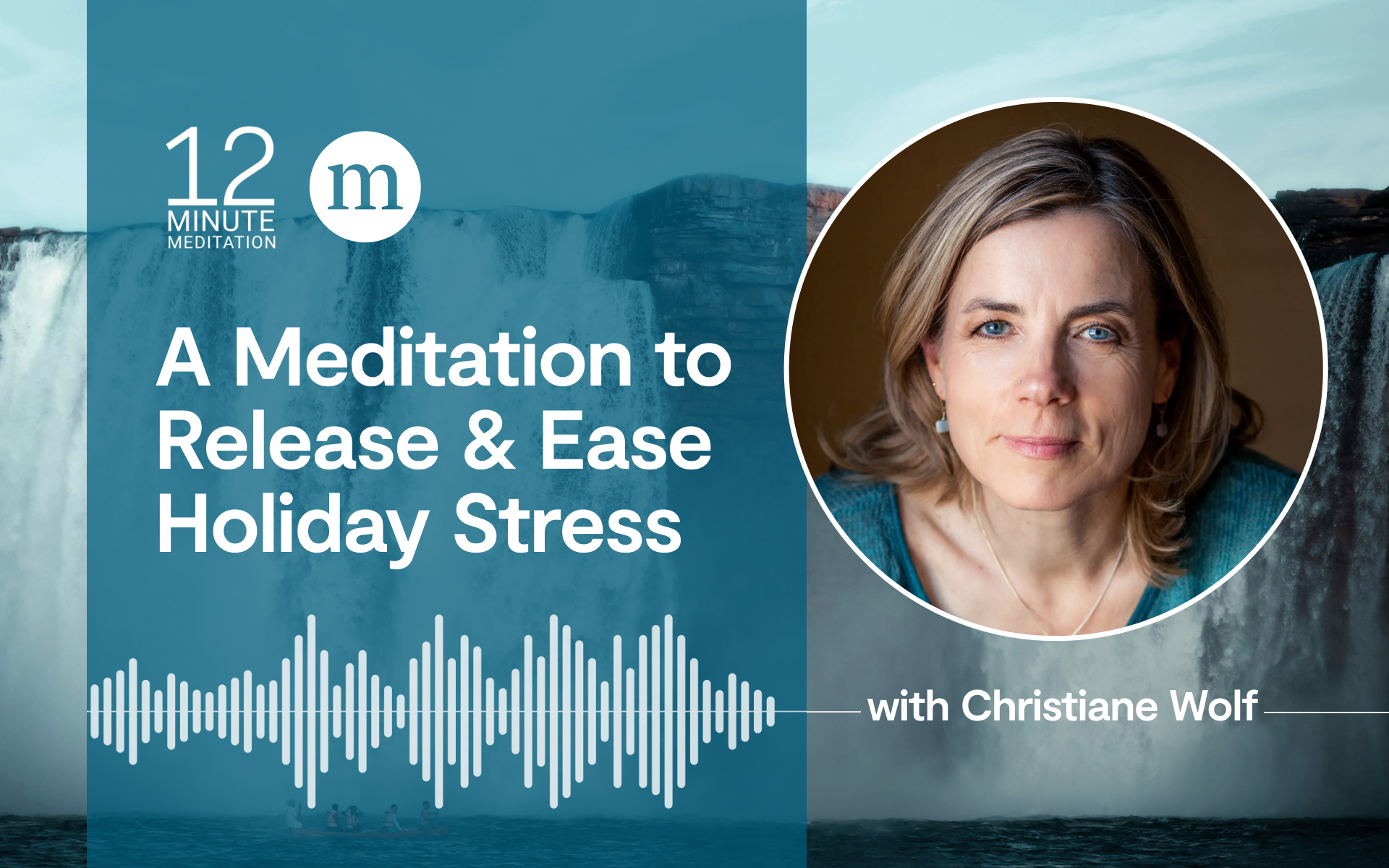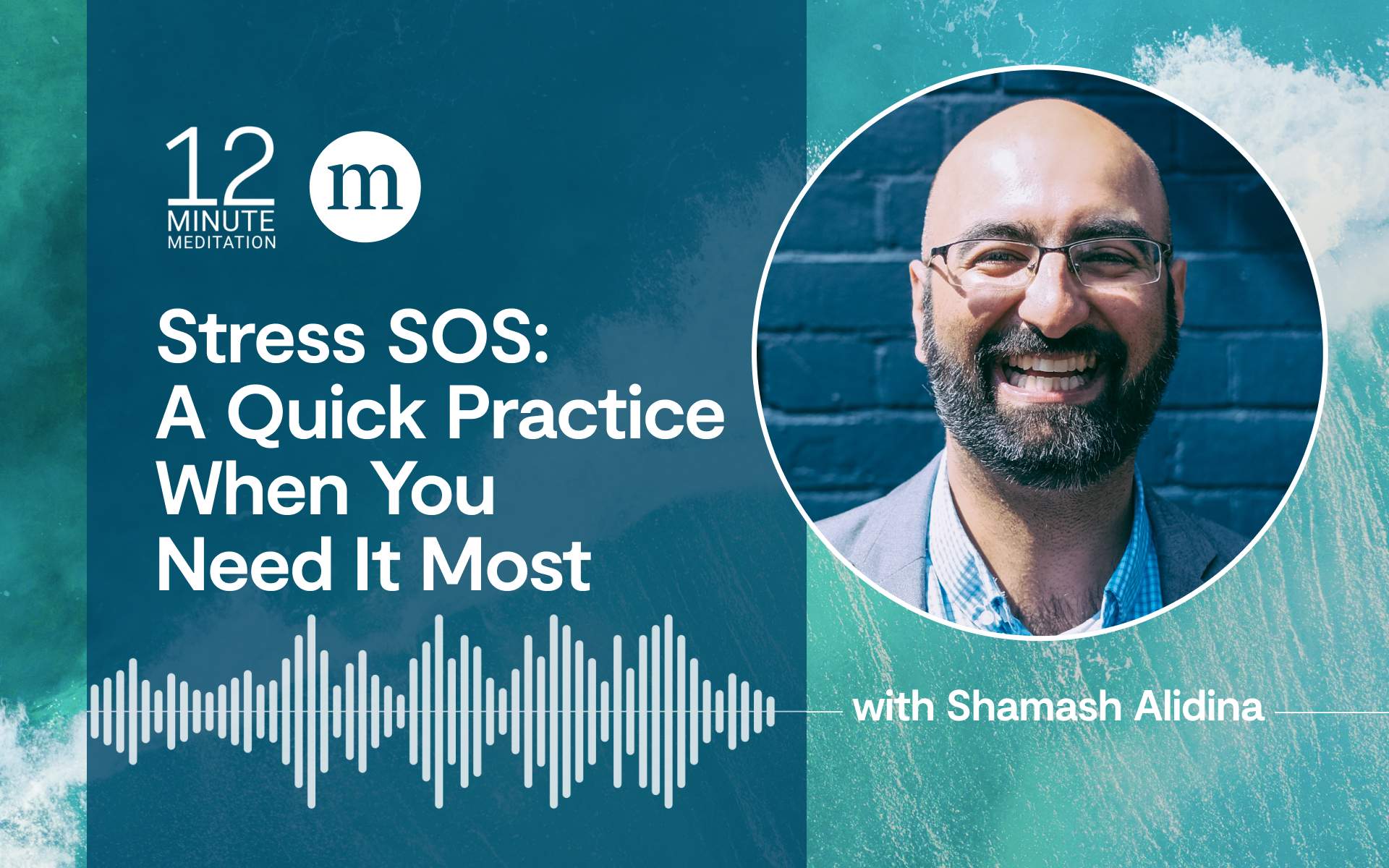There comes an important moment in your mindfulness journey when you’re called to share your at-home meditation retreat with others. You might be asked to share a mindfulness exercise in a meeting, asked by your partner to help soothe a mid-meltdown child, asked by a grieving friend how you managed through loss in your own life. It’s a small yet monumental call to take something deeply personal and offer it back to the world. And you don’t have to be a mindfulness teacher to meet the moment.
In 2016, I started a weekly mindfulness group at work with two colleagues. We pitched the idea, secured a nominal budget, and brought in a certified teacher from a local meditation center. We sat in a conference room, partially cross-legged in restrictive business casual, and felt genuine joy when close to 20 of our coworkers practiced within the walls of our corporate office without a trace of insincerity.
We also soon realized that we didn’t have an endless budget to bring in teachers every week. We could run these sessions a few times a year but had to fill the weeks between with our own content. As the yoga teacher of the group, I was asked to share a mindfulness exercise in the next meeting. And my immediate reaction was, “Am I really qualified to do this?”
A good teacher not only guides through their expertise, but they know that the true teachings are found within each one of us.
I wasn’t a certified mindfulness or meditation teacher at the time. I admired and respected my own teachers who studied, practiced, embodied, and taught mindfulness over many decades. Teachers play an essential role in preserving and deepening collective wisdom. A good teacher not only guides through their expertise, but they know that the true teachings are found within each one of us and, after a lifetime of trying, erring, and persevering, they know how to create kind space for wisdom to arise.
I didn’t have deep expertise. Mostly, I had “trying and erring.” And that made me very similar to my conference-room peers. I couldn’t teach mindfulness, but I could share my own experience—just a few years down the road of perseverance.
Here’s how I describe the difference between sharing your practice and teaching the practice:
Teaching is like gifting someone your secret recipe (most often through example) and knowing that the best meals are made together. A great teacher makes it possible for you to find your own way around the kitchen, too. They not only guide and connect you to your inner knowing, they learn from you as well. Teachers give us recipes for wisdom that last a lifetime.
Sharing is like bringing a salad to a dinner party. You’re taking some simple ingredients from your practice that resonate with you, arranging them as best you can, and offering it to someone else in case they’d like to try it, too. Sharing is saying, “I’m right here next to you, trying the same things you are.” Sharing takes your own big, insightful ideas and breaks them down into understandable, easily communicated bites. It’s not a substitute for a teacher’s expertise; it’s an offering to share your own experience.
Create a Retreat at Home with Friends
We’ve gathered some guidelines and practices as an invitation to begin crafting your own retreat experiences at home, maybe with friends or family members. Sharing your practice with others isn’t a call to replace the expertise of teachers; it’s an invitation to bring a thoughtful relatability to moments of reflection. Here’s a list of questions for exploring the stories, benefits, and tips you might want to consider sharing about your practice.
How has meditation changed your behavior or reactions? How would your partner or someone close to you describe its impact on you? Look for objective, tangible stories about how it helps.
When are you motivated to practice? When do you lose motivation, and how do you overcome it? Connect with your own reason for continuing to practice.
When has life gotten in the way of your practice, and what did you do with that challenge? Share the silly, real stories—like the challenges of meditating in a home with young children.
What do you know about meditation from experience, and what do you know because someone taught you? Acknowledge honestly where you are and articulate the limits of what you know.
Day 1: Connect With Awareness
By Mark Bertin
What you share about your practice will hopefully benefit someone else, but it will certainly serve you. We learn a subject more intimately when we put it into our own words and explain it to someone else. We deepen our awareness, share our presence with others, and enrich our understanding of the practice. Follow these two meditations to cultivate your full attention and in turn encourage others to settle in the present moment with you.
A 5-Minute Meditation to Set Intentions
A Meditation to Set Intentions
Each time we sit for a few minutes, there’s an opportunity to let go of wherever we’ve gotten caught up in, come back, and realign ourselves with our best intentions and efforts. It might be a sense of bringing full awareness and attention to our experience, to the people around us, to a conversation with our children. It might be a sense of letting go of reactivity and coming back to resolve with more patience and clarity. All of that can be cultivated, sustained, and developed through any amount of time we spend in our mindfulness practice.
- Settle into a comfortable posture. You can lower your gaze or shut your eyes.
- Check in with your intention. What is it you’d like to bring to the practice today?
- Bring that sense of intention and awareness to your practice today. One way to do that can be within each in-breath, developing a sense of open awareness.
- With each out-breath, come up with a word that captures your intentions for yourself. Breathe in with awareness. Breathe out with your intentions for this moment.
- If your attention wanders, re-engage with your intention for the practice. If your mind gets caught up in distraction or reactivity or some sense of discomfort, that’s normal. Gently bring your attention back with awareness.
6. Pause for a moment. Gently move on with your day, bringing the gifts of this practice with you.
A 5-Minute Meditation to Be Kind to Your Mind
A Meditation to Be Kind to Your Mind
This meditation trains your attention so you can learn how to choose what you’d like to focus on rather than letting your mind wander around unattended. A wandering mind is a potentially dangerous thing. The more you can notice when your mind has wandered, the more chances you have to bring yourself back to the present moment. Please, proceed with kindness for your naturally-wandering mind.
- Find a comfortable posture. If you’re sitting in a chair, place your feet on the ground and lift your back up off the chair so you’re sitting upright and alert.
- Drop your gaze. If you’re comfortable, and you’d like to, you can shut your eyes. You might notice that even as you start, your mind may already be off somewhere else.
- As best as you’re able to, bring your awareness back to your body. Notice how it moves with each breath you take. If you like, you might label the sensations as “breathing in” and “breathing out.” There’s nothing to do. Nothing to fix. Nothing to change.
- As many times as your mind wanders off somewhere else, come back to the next breath again. When you’re ready, open your eyes and lift your gaze.
Day 2: Connect With Self-Care
By Tovi Scruggs-Hussein
We’re all being called to tap into deeper wells of courage and resilience. For those of us leading in this way, self-care is critical, not optional. It’s a lifestyle commitment. Because our culture does not support resting as a way of being, resting is an act of courage. Resting is about restoration. To restore is about doing differently, so that we are being differently. It’s about doing something good for you, but it’s also about not doing. What can you not do in order to restore?
A 10-Minute Meditation to Cultivate the Courage to Heal
A Meditation to Cultivate the Courage to Heal
Research shows that resilience is cultivated by supporting emotional balance. One way to balance our emotions is to name what is unbalanced within. We do this in order to connect and lead from a place of wholeness and in order to be skillful in our interactions with those we serve and love.
- Lower your gaze or close your eyes. Take three deep breaths at a natural pace. With each breath, anchor into the present moment with full curiosity, non-judgment, and deep self-compassion.
- Settle into breathing, finding the rhythm for your in- and out-breath. And bring your awareness to the present moment.
- Breathe into this truth: When I heal, the system I serve heals, ultimately creating conditions that we no longer need to heal from.
- Place your hand over your heart and breathe into the truth and the beauty of knowing that our own healing creates compassionate conditions for those we love. Honor this moment by staying connected to your breath, acknowledging what arises without any judgment. Whatever arises, know that you have the courage to meet it.
A 10-Minute Meditation to Welcome Rest
A Meditation to Welcome Rest
Resting is not self-indulgent; it’s not selfish; and it’s also not just anything that feels good. I created an acronym for rest in my work: restoratively embracing self today. We all give and do so much, and rest is a key responsibility to ourselves. This means that we honor ourselves by resting and we model this for others by example. By resting, we give others permission to also rest.
- Lower your gaze or close your eyes. Take three deep breaths at a natural pace, signaling to your body and mind that you’re about to practice. As you settle in, gently remind yourself to stay open in this moment with full curiosity, non- judgment, and a deep sense of self-compassion.
- Invite in rest with each inhale. Invite in deeper rest with each exhale, without any effort. Just breathe in and out.
- Notice where you are breathing from—simply notice, with no judgment. Are you breathing from your throat, your chest? Or are you breathing from your abdomen?
- Bring your breathing into your abdomen. If you’re breathing from your abdomen, bring your breathing deeper into your belly. Notice what it feels like to breathe more deeply.
- Support yourself by breathing at a pace that feels good to you. As you breathe deeply from your abdomen, you massage your nervous systems with each in-breath and out- breath. Breathe freely and rest.
- Bring your attention back to the breath, returning to the rhythm of your breath with each in-breath and out- breath, increasing your awareness, becoming more present, allowing for the spacious- ness of rest in your presence and in your body.
- When you’re ready, open your eyes and return, fully present.
Day 3: Connect With Curiosity
By Shalini Bahl-Milne
When sharing with others, we immediately see how their needs, experiences, and interpretations differ from ours. It helps us loosen our ideas of how mindfulness has to work, and focus on how it could work. Show up every day with openness and curiosity by engaging in these two practices to connect with what’s most important to you—and what’s most important to those around you.
A 10-Minute Meditation to Return to Your Senses
A Meditation to Return to Your Senses
If we draw from a pool of resources without replenishing them, we can begin to feel depleted—our brain gets sluggish, and we don’t make good decisions. By resting our attention on our senses, we are taking a moment to reconnect with ourselves and feel fully present.
- Find a supported posture. You can do this practice while walking or sitting. You can also take this practice outside if you have access to a quiet space. Lower your gaze or close your eyes—if you’re not walking.
- Start with the sense of touch. Feel any sensations of touch in your feet and the contact they make with the floor. Can you feel the touch of any footwear, or if you’re barefoot, the touch of air on your skin? Where else in your body can you feel the air touching your skin?
- Now shift your attention to sound. Notice the sounds in your environment or within you. Note how some sounds may feel pleasant, some are unpleasant, and some are neutral. You may discover that your mind has wandered, and that’s natural. As soon as you notice that, return to your sense of sound and receive the sounds with kindness. You can choose to stay with your sense of touch or sound, or you can shift your attention now to smell.
- Notice the scents around you. If you’re outdoors, you may discover very different scents than what you find inside your house or office. With spaciousness in your mind and body, receive any scents or absence of scents. As we refine our ability to smell, staying here open and receptive, we may start to uncover newer scents that we had not noticed earlier. Stay here for a few more moments. You can choose to stay here with the sense of smell or return to your sense of touch or sound.
- Open your eyes and look at an object in front of you with fresh eyes. Without getting lost in labels or judgments, see the object as if you’re looking at it for the first time. Note the textures, colors, lightness, darkness. Make a note of how it feels to give your full attention to your senses.
A 10-Minute Meditation to Act on What’s Important
A Meditation to Act on What’s Important
We feel most energized when we find purpose and meaning in what we are doing. But, on the other hand, we can feel depleted when we don’t take time to do activities that are inspiring or important to us. Create some space and time to reconnect with yourself and ask, “What’s most important to me?”
- Find a comfortable posture. Lower your gaze or close your eyes. Then, take a moment to return to yourself, to your breath.
- Let go of any ideas of “shoulds” and “I must” and “this is right or wrong.” Allow yourself to be fully present, with no agendas, and nothing to fix. Take this time to meet yourself, just the way you are.
- If you find your mind is busy, try placing your hand over your heart. Feel the warmth of your hand and the connection with your body. Let your breath move naturally in and out of your body. Give your full care and attention to the natural rhythm of your breath, rising and falling within your body.
- With each inhale, create a little more space in your mind, chest, abdomen, and whole body. With each exhale, let go of what you don’t need to hold on to for the time being.
- When you feel present, relaxed, and alert, invite the question, “What is most important to me in my life?” There’s no need to search or strive. Stay with the question, “What is most important to me?” and allow thoughts to naturally surface and emerge. Maybe it’s just a silent whisper, “What is important to me?” Listen in. Stopping to make this space, to meet yourself, is enough. So even if you don’t find any deep insights, being with your breath, your body, yourself in silence, is enough.
- If this practice feels awkward, that’s OK. Note it with kindness, realizing that being in silence can sometimes be hard. If it’s easier, you can open your eyes and try some journaling. When you ask the question, “What is most important to me?” allow yourself to write whatever comes up. Write honestly, since it’s just for you and no one else.
read more
A User’s Guide to a Journey Called Mindfulness
Mindfulness meditation is not a one-time thing. You do it again and again. As you keep doing it, a variety of challenges emerge. Here’s some advice for traveling the path of meditation. Read More
Here’s How You Can Share Your Mindfulness Practice (Without Teaching It)
While we can’t replace the expertise of mindfulness teachers, we can all find respectful ways to share our practice with those around us. Read More
How to Find a Mindfulness Meditation Teacher Near You
The Mindful Directory is a rich new resource, uplifting mindfulness leaders and practitioners at all levels to help access the teachers and events to take your mindfulness practice further. Read More








